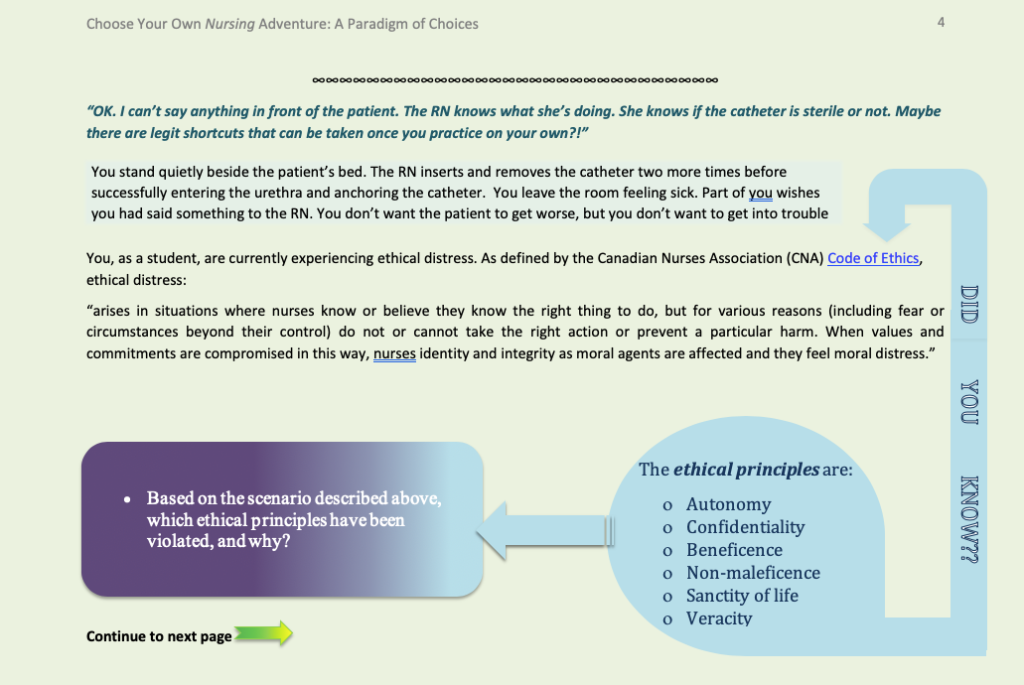The Choose Your Own Nursing Adventure was created from an interest to see how technology could be integrated into the traditional case study approach to enhance student engagement. The approach is modeled on the popular children series from the 1980s and 1990s, Choose Your Own Adventure, written by Edward Packard. Each of these short novels was written in second person and allowed the reader to make choices that influenced the main character’s actions, the storyline, and the overall outcome.
We wanted to replicate that in nursing education. The goals of the module were to: 1) Provide a higher level of critical thinking as well as create an environment that supports the co-creation of content; 2) Provide an interactive platform through which to engage students in a meaningful way; and 3) Introduce an element of choice and unpredictability to learning spaces.
Several pedagogical considerations went into the creation and development of this tool. First, the scenario had to be consistent with a real-life nursing situation. Ideally, the situation would be complex or controversial and require the students to problem solve, examine multiple perspectives, and choose a pathway for themselves. This allows students to choose an incorrect or inappropriate pathway or action without consequences to their grades and without an audience or public evaluation.
Students are also provided with additional resources to support their comprehension of concepts. These supports could be professional associations, organizations, guidelines, documents, etc. In addition, as this tool was designed to be academic in nature, it includes comprehensive evaluative components (i.e. quizzes, short essays, role playing scenarios). The components are included within the tool for student convenience, though they could be outside of the tool in an LMS or links to outside sites as well.
Choosing your adventure
The students begin by reading a scenario, in this case, a nursing student who witnesses a registered nurse break infection control protocols while conducting a procedure. The initial decision is whether to inform their instructor or to remain silent because they do not want to get the nurse in trouble. Depending on the initial choice made, the adventure will choose one of two pathways, presented as a hyperlinked statement or question, for the student to move through.
The student is then given teaching content that is identical in both pathways because it is important general information for the student to understand no matter what choice is made. This addresses the common problem with adaptive learning that students can miss important lessons or lose a sense of coherence to the content when they skip some material to arrive at content that is specific to a choice. For example, regardless of pathway selected, students are taught the importance of infection control and implications for breaching it, a breakdown of the physiological process of how bacteria enters the body and creates an infection, as well as signs and symptoms. This ensures that all students get basic principles of nursing as taught in an introductory nursing course.
The students are then given content specific to their choice. Should the student choose to inform the instructor, the interface will suggest information on advocacy as well as ethics modules that highlight the importance of patient advocacy. This pathway outcome results in a student building positive relationships with the instructor, patient, and nurse and leaves the student feeling competent in their knowledge, assessment, and advocacy skills. Should the student choose to remain silent, the interface provides content that focuses on the outcome for patients who have unchecked infections, as well as the ethical distress, and anxiety, and reinforces the impact of a nurse’s actions on a patients well-being. Once the scenario ends, the student is given a final choice to return to the main page and choose differently.
See an example of the teaching content below:

Setting up the adventure
The adventure began as a simple Word document. Students made choices and were taken to different content via links to different sections of the document. But this form had very little interactivity or graphics, and lacked an engaging interface.
From there we created an eBook using iBooks Author. This allowed for greater visual engagement and the integration of additional educational components. For example, video and audio was embedded into the eBook to enhance the content, and we integrated high-quality graphics to enhance options for comprehensive testing and quizzes.
However, the eBook turned out to be quite advanced for students to navigate, and not everyone had the Mac iOS operating system needed to access it. As a result, we went back to a Word document but incorporated more engaging content. We changed page background colors and added graphics such as photos, interactive flow charts and emojis. We also added links to outside resources and word bubbles with multiple choice questions or video links. The final version was converted into a PDF to make it universally accessible.
Future uses
This Choose Your Own Adventure style of teaching can be used for a variety of topics. Students in business courses can be given modules that take them through different types of business decisions, such as whether to borrow money to start a company. Students in science courses can be given different scenarios concerning how to conduct laboratory experiments and what to do in response to different problems or results. The adventure can be completed individually, in pairs, or in a larger group, promoting a deeper connection to the course concepts which in turn supports in-depth and comprehensive learning. Moreover, as students are going through a module, they can be required to seek out and use additional resources to support their decision-making. There are countless ways for this self-directed style of learning to incorporated into a course.
April Mackey is an instructor of nursing at the University of Saskatchewan.






